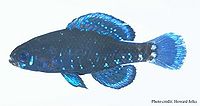Okefenokee Pygmy Sunfish (Elassoma okefenokee)
From The Aquarium Wiki
(Redirected from Okefenokee Pygmy Sunfish)
Okefenokee Pygmy Sunfish
Elassoma okefenokee
95 Litres (25 US G.)
2.5-3.4 cm (1-1.3")
Freshwater
6.0 - 8.0
4 -30 °C (39.2-86°F)
6-20 °d
1:2 M:F
5-8 years
Family
Elassomatidae
Contents
Additional names
- Okefenokee Pygmy Sunfish
Additional scientific names
- Elassoma evergladei orlandicum
Origin[edit]
- North America: Lower Altamaha River drainage, Georgia south to central part of peninsular Florida, and west to Choctawhatchee River drainage, Florida, USA.
Sexing[edit]
- The male turns black with blue sparkles while the females remains clear, tan, and light brown.
Tank compatibility[edit]
- A generally peaceful fish which should either be kept in species tanks or with peaceful and similar sized mid-bottom dwellers. Males will chase other tank mates if they're spawning.
Diet[edit]
- They eat small crustaceans, aquatic insects, young snails, and other microfauna. Some good foods to try in the aquarium are california blackworms, daphnia, microworms, and having a healthy population of snails. Some pygmy sunfish will learn to supplement their diet with crushed flake food, but this should not be relied upon as the only food source. The crushed fish flakes are a good idea, though, because they will feed the microfauna that will in turn feed the Elassoma.
Feeding regime[edit]
- Because these fish graze all day long on food in the wild, a constant food supply in the aquarium would be best. If the tank had a healthy population of blackworms, the Okefenokee pygmy sunfish can eat them whenever it is hungry.
Environment specifics[edit]
- Heavily planted aquariums with finely leafed plants such as Ceratophyllum demersum and Cabomba caroliniana.
Behaviour[edit]
- The males spend most of their time displaying and dancing for the females. They constantly patrol their territory, chasing off invading males and attempting to woo females into their plants to spawn. Males will chase all fish away, even females, for several days after spawning to protect the eggs until they hatch. After they hatch he will continue his dancing and spawning routine.
- Okefenokee spend most of their time near the shelter of fine leafed plants. If the plants extend all the way to the surface, densely, then the Elassoma will inhabit them. If the plants are mostly dense around the middle and bottom of the tank, then that is where you will find the fish.
Identification[edit]
- Elassoma okefenokee differs from its close relative Elassoma gilberti by possessing three preopercular canals (gilberti has, on average, four). The average number of anal fin rays is seven in E. gilberti and eight in E. okefenokee. The female E. gilberti often expresses a blue patch of colour behind her eye and on her body, while the E. okefenokee does not.
Pictures[edit]
External links[edit]
- Fishbase (Mirrors:
 )
)
